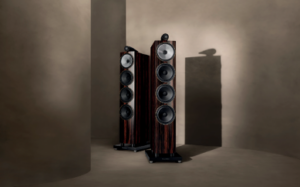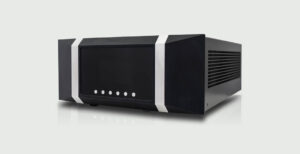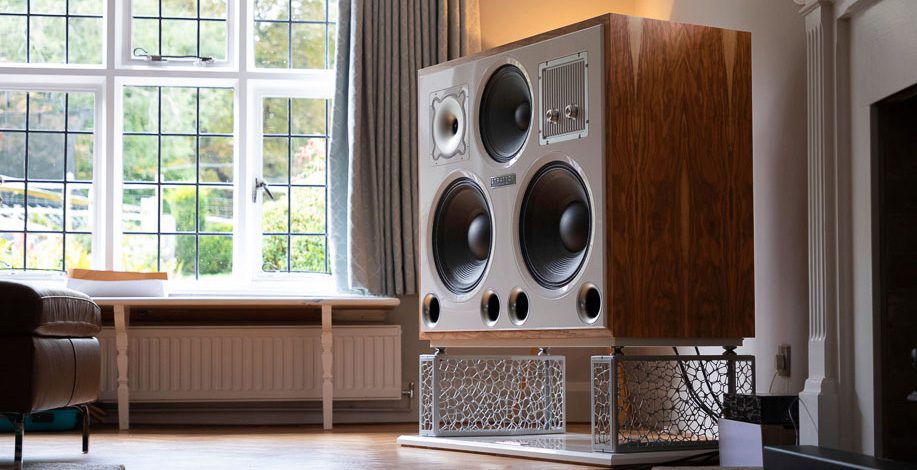
You don’t often find decent speakers in a charity shop/thrift store, so the fact that Stratton Acoustics co-founder Dave Fowler came across a pair of JBL 4350s in one is just damn bizarre. This experience of a tatty but not inexpensive pair of this gargantuan 1970s studio monitors is what set him down the road that ended up at the mighty Elypsis 1512. In pictures, this speaker doesn’t look as big as it is in real life, nor does it sound the way you might expect, but I will try not to get ahead of myself.
The connection between the Elypsis 1512 and the aforementioned JBL is solely in the size and arrangement of the mid and bass drivers, which as the name suggests are 15 inches for the bass and 12” for the midrange. Driver sizes that went out of fashion when stereo came along and meant that a single giant corner horn or similar was no longer where it was at. At that point speaker makers had to produce smaller boxes and, in the real world at least, those boxes have been shrinking ever since. I saw a tower speaker at the 2023 Audio Show Deluxe show with bass drivers of this scale (Marco Serri Design) but it used multiple smaller mids, the Stratton Acoustics does not compromise its choice of drivers for the sake of a slimline cabinet, quite the opposite.
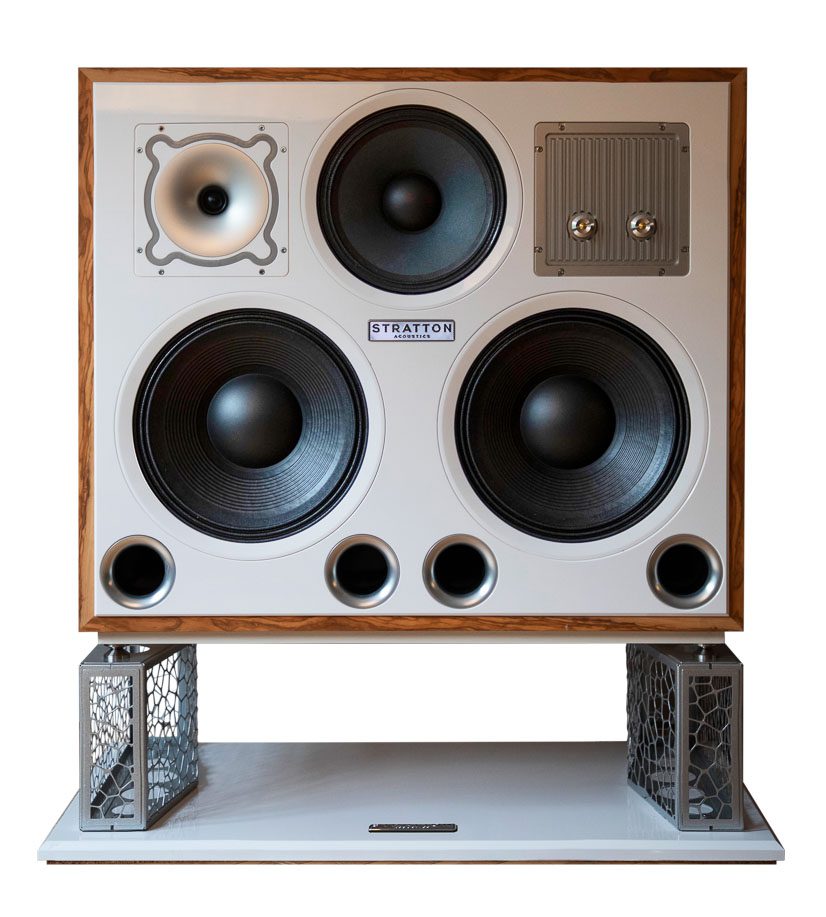
With some solid industrial design as a foundation stone for Stratton, the acoustic side of the Elypsis 1512 was laid down by speaker guru Phil Ward. His CV includes Mordaunt-Short, Canon and Naim, among others. Phil was initially sceptical about the idea behind this design but when he considered how much professional drive units have advanced in the last decade or so he realised that it had potential, and soon became one of the Founding Partners of Stratton.
Big cones have one significant advantage over their smaller cousins and that’s their large area. It means that they can move air with considerably less excursion (movement of the voice coil). Phil Ward reckons that the midrange driver doesn’t move much more than plus or minus a millimetre even at high domestic listening levels, and the bass units might push that to 1.5mm. They are capable of up to 14mm of excursion but unless you live in a field your ears would be kaput by then.
Power handling
The Stratton Acoustics cabinet is a metre wide by 50cm deep and 90cm high and is constructed from heavily braced birch ply, combine this with an acrylic facia and the selection of drive units and the weight ends up in the region of 140 kilos. But it’s not about brute strength, the midrange has its own sealed enclosure as does the tweeter. The latter is isolated with a polyurethane strip that you can see in light grey around the large waveguide. This guide increases sensitivity and goes some way to matching the dispersion of the tweeter to the huge midrange driver next to it. Large drivers like this tend to beam significantly, the higher the frequency being reproduced the smaller the area of the cones that moves. The tweeter itself has a 29mm fabric dome in a 34mm roll surround, so it’s larger than average and combined with the waveguide this means it has sufficient power handling to keep up with the cones.
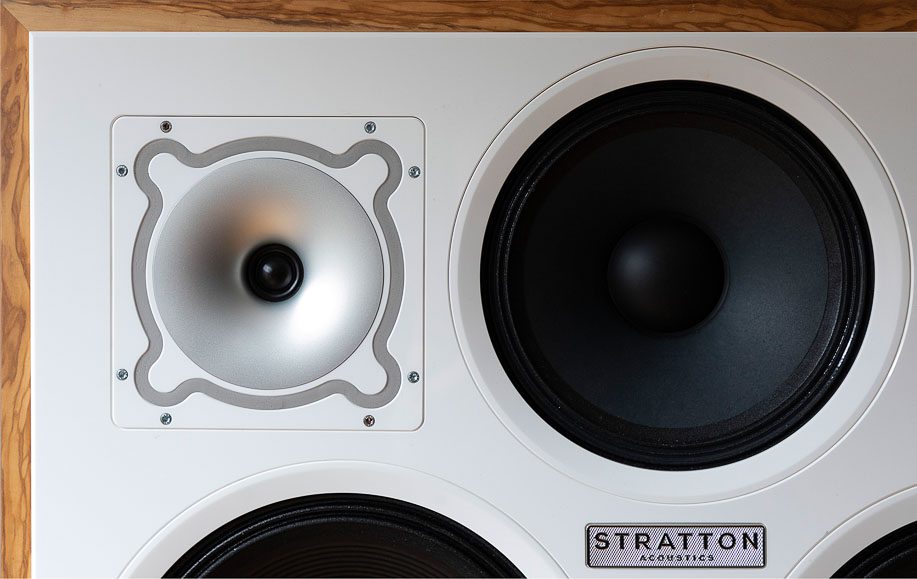
Stratton provides level controls for mid and treble, these are in machined aluminium with brass centres and offer plus or minus 2dB of adjustment. This largely because the Elypsis 1512 is such a substantial and thus difficult to move loudspeaker, the plinth which is part of the stand has a cork base making it highly disinclined to slide on a carpeted floor. I got around this with six large furniture sliders under each one, these allowed a degree of tweaking albeit no more than a few inches in any direction. Installation is a remarkably smooth process thanks to company co-founder Ben Richards’ cunning use of shipping crates with wheels and no fewer than three scissor jacks. Each speaker took under half an hour to install and no one’s back was broken in the process, always a bonus with high end audio!
The stands themselves are dramatically modern compared to the loudspeakers, they consist of a plinth which is a bit larger than the speaker and supports two perforated steel ‘legs’. The shapes that are laser cut into the metal legs are in a Voronoi pattern which imitates a dragonfly wing by virtue of having no two holes of the same shape, thus eliminating the potential for ringing.
The stands don’t look strong enough to support the speakers, but in fact they are exceptionally strong, light and rigid – and more than capable of holding up the ‘girthy’ 140kg weight of each loudspeaker. They are also visually discreet enough to make it look as if they are almost floating. Given the original JBL often used to end up resting on house bricks or concrete ‘breeze blocks’, Stratton sets off on the right foot!
Stratton is offering these speakers at three finish levels, Pure is a textured paint finish, Bespoke is the level shown with real wood veneer, this pair in olive, and Absolute “places no limits on what is possible”. So a totally custom build in any fashion you fancy; Stratton say that it’s only limited by your imagination, but I suspect that Dave Fowler’s industrial design background might be of help here.
Dispersion null
One of the qualities that really struck me about the Elypsis 1512 is how good they sound at low levels, I presumed that this was largely due to the high 96dB sensitivity but Phil Ward had this to say: “I suspect one reason might be dispersion. The 1512, due to both its big drivers and its, err, “largish” front baffle area starts to become horizontally directional from about 300Hz upwards. That’s more than an octave below the dispersion narrowing frequency of a typical narrow baffle speaker. The 1512 also has a dispersion null at 90° horizontally off axis due to cancellation from the spaced bass drivers – this also occurs at around 350Hz, so the first side wall reflection to the listening position will likely have a null slap bang in the middle of the voice-band.
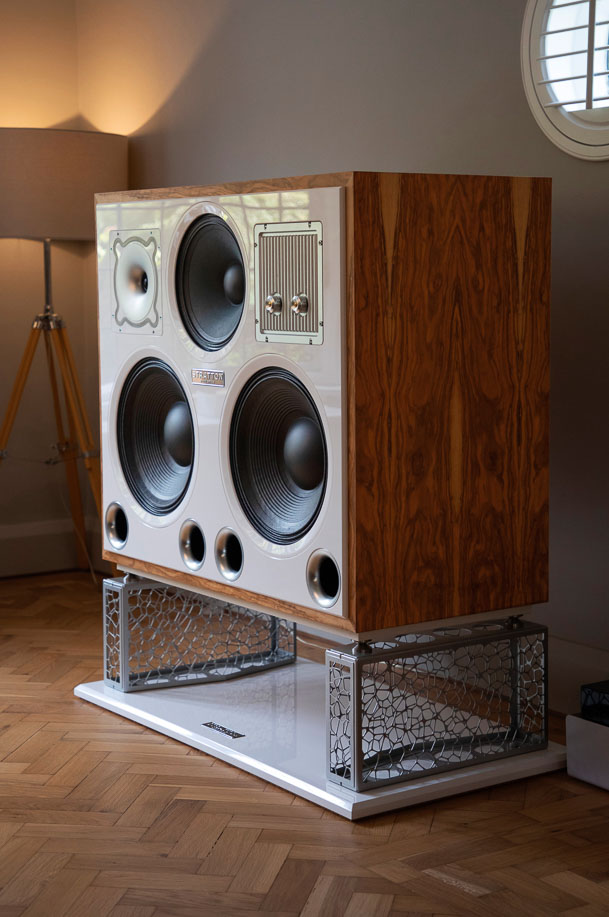
“The upshot of all this is the 1512 drives room acoustics rather differently compared to typical narrow baffle speakers – it pushes back the point in the room where the far-field (where reflected sound energy begins to dominate over direct energy) begins. This means that, even at a relatively distant listening position, direct sound will be more dominant. This of course has an effect at all listening volume levels, but anything that reduces the effect of the room is likely to help with the perception of detail and general intelligibility.”
I do not have the luxury of far field listening, the Strattons were three metres in front of the listening position at most. They were not far from the rear wall though, 50cm or so and in a quest for more bass I tried pushing them closer but that started to thicken the sound so they were pulled back again. Phil set them up with the tweeters on the outside and about 30 degrees of toe in, but after a few hours I reduced that by about five degrees to reduce the mid/treble slightly. That resulted in a phenomenally revealing presentation that worked beautifully with decent recordings but was unforgiving of those with dirty or excessive mid/treble energy, so I turned both mid and treble output to minimum and all was well, very well in fact.
I mentioned that these speakers don’t sound the way they look, which is bass-heavy in the ‘dub shack’ style, but unless you play some dub (and why wouldn’t you) they sound as clean and controlled as a well designed high end loudspeaker should, perhaps more so. I tried a push-pull, 350B-equipped tube amplifier and this delivered extremely high transparency coupled with total ease that was only undermined by high mechanical noise from the amp and a higher noise floor through the speakers.
Switching over to my regular Moor Amps 150W power amp proved a good move. The total ease continued along with leaner tone but the balance of resolution and muscularity it delivered was superb. Now I could hear the cartridge warming up track by track and the compression on Hannah Reid’s voice singing ‘Hey Now’ (on London Grammar’s eponymous first album), but also the glory of the track and the juiciness of the bass on it. These may not be bass monsters, but they go all the way down and do so without effort. You get all of the texture, dynamic shading and attack/decay of each bass note without the sense that the system is having to try or that the cabinet is joining in.
Space and time
The Elypsis 1512 may be big but it doesn’t join in with the music in any apparent way. In fact, the mechanical noise floor is extremely low. The ports don’t chuff, the box doesn’t vibrate, and the drivers don’t lose composure even at high levels. They sound so relaxed, you can play them at high volume and not feel that it’s loud, as there is little in the way of ‘loudness’ because of the lack of strain from either amplification or loudspeakers. What you do get is a sense of there being more time to appreciate the music and hearing more of the space within it. Imaging in height and width terms is good but not fantastic and the size of the cabinets means that depth is not resolved as well as the best contemporary floorstanders, but there is nonetheless plenty of space if its on the record.
Even on less sophisticated recordings such as John Lee Hooker’s Burnin’ (recently re-released by Craft Records), the character and power of the performance is placed front and centre. The crudeness of the recording is obvious as is its double mono nature, but the reason why it remains a great listen is not really to do with that, it’s about the soul that the artist managed to lay down in the studio despite all these limitations. Better productions do naturally shine, Joni Mitchell’s Mingus being a great example. Here, Jaco Pastorius’ brilliant bass playing works so perfectly with Joni’s voice and the acoustic guitar, with the bass sounding as articulate and clear as everything else in the mix. ‘The Wolf That Lives In Lindsey’ is a standout from this strong album that’s full of clattering guitar strings and slapped bass, and was one of the many pieces that gave the impression of the Strattons finding more space and time than is usually the case.

Their size made it hard to access the system but I used the Elypsis 1512s to evaluate various source components including the new Melco N5 music server. Melcos generally sound a bit too relaxed when played from their USB outputs for my tastes and I use a streamer to do the conversion to PCM/DSD, here the N5 sounded very good via this connection. It’s a bit more precise than my N10 reference and worked a treat with the Strattons. I also tried slipping three Ansuz Darkz T2 titanium feet under the iFi Pro iDSD Signature DAC. This brought about a shocking increase in bass resolution and power. I’ve tested these feet before but the benefit has never been so dramatic.
Bigger than Japan
A speaker like this attracts fellow enthusiasts as you might imagine and all that visited ended up with broad grins on their faces. One encapsulated their sound as “pleasant precision” which sums the Elypsis 1512s up rather well. Precise speakers tend to be impressive but hard to love whilst relaxed ones are easy to enjoy but lack high resolution, these manage to combine both strengths to a remarkable degree. Another listener suggested playing ‘New Moon at Red Deer Hollow’ by Rain Tree Crow and that proved a very good idea, the bass on that is deep, dark and lustrous, who’d of thought that the band formerly known as Japan could produce such a sumptuous piece.
As you can hopefully tell, I had a whale of a time with the Stratton Acoustics Elypsis 1512s, not least when they were playing at levels you could have a conversation over, here they excelled at least as much as they did at high levels. I hope that other manufacturers and dreamers take note of what Stratton have achieved with this unconventional design, it proves that big can be beautiful in ways that small speakers can only dream of.
Technical specifications
- Type: three-way, four-driver stand-mount monitor with front-ported bass reflex enclosure.
- Driver complement: 29mm waveguide loaded NeFeB motor soft dome tweeter, one 300mm selectively hand doped paper diaphragm and NeFeB motor midrange driver, two 380mm paper diaphragm and ferrite motor bass drivers.
- Frequency response: +/- 2dB 45–18,000 Hz (-6dB @ 28Hz)
- Crossover frequencies: 350 Hz, 2.5kHz
- Impedance: 8 Ohms
- Sensitivity: 96dB/2.83v/m
- Dimensions (H×W×D): 900 × 1000 × 500mm, with Voronoi stand 1200 × 1100 × 600mm
- Weight: 140kg/each
- Finishes: textured black or white, unlimited custom options.
- Price: from £82,800
- Stands £5,000
Manufacturer
Stratton Acoustics
Tags: STAND-MOUNT LOUDSPEAKER STRATTON ACOUSTICS ELYPSIS 1512
By Jason Kennedy
More articles from this authorRead Next From Review
See all
PrimaLuna EVO 100 phono preamplifier
- Apr 22, 2024

Reiki Audio SuperSwitch Master Pro + Servant Pro
- Mar 27, 2024

Melco Audio N1-S38 music server
- Mar 27, 2024








